Macro methods
Feb 27, 2019 09:48:31 #
gvarner
Loc: Central Oregon Coast
High quality closeup filters are decent. Quality falls off at the edges but most of a closeup subject is in the center anyway. Plus, I don’t think that they reduce the light like extension tubes do.
Feb 27, 2019 10:14:19 #
Picture Taker
Loc: Michigan Thumb
Look up Mike Moats and his on line stuff. I think he is the best. He likes reasonable equipment and common sense.
Feb 27, 2019 10:43:27 #
fetzler
Loc: North West PA
The cheapest way to get into macro is to use extension tubes. They should work well with a lens in the 50 -100mm range when photographing 3D objects (flowers etc.). For copy work macro lenses are need for their flat field. Most of my macro work is done using manual focus even though I have auto-focus lenses.
Stay away from close up lenses they a almost always bad. For magnifications > 1x, I have used Raynox lenses DCR-250, MSN-202 and MSN 505. They are quite good. They come with a clamp on adapter that does work but I prefer using appropriate step down rings. These lenses work fine for magnifications <1x too.
Stay away from close up lenses they a almost always bad. For magnifications > 1x, I have used Raynox lenses DCR-250, MSN-202 and MSN 505. They are quite good. They come with a clamp on adapter that does work but I prefer using appropriate step down rings. These lenses work fine for magnifications <1x too.
Feb 27, 2019 12:01:19 #
amfoto1
Loc: San Jose, Calif. USA
CanonAbuser wrote:
Greetings, I'm a newby to DSLR's and I'll likely t... (show quote)
I would encourage you to get macro extension tubes. They are a low cost way to "do macro" with lenses you already have. The Kenko set of tubes for around $130 is very good. There are cheaper, but more plasticky and lighter built Vello (and others) that can do the same, about $80 for a set.
DO NOT waste your money on really cheap extension tubes... under $25. Those lack the electronic contacts to control auto focus and, much more importantly, to be able to set the aperture on modern electronically controlled lenses. The Kenko, Vello, etc. tubes have electronic contacts. The Kenko are similar in quality to Canon's own tubes. However, the Kenko and Vello sets contain three tubes: 12mm, 20mm & 36mm. Canon's tubes are only sold individually and in two sizes: 12mm and 25mm. One Canon 25mm tube costs more than the the Kenko set of three.
Macro tubes are very easy to use. Simply install them between your lens and the camera. The longer the lens focal length and/or the higher magnification you want, the more extension you'll need. Experiment. Usually you will find it easiest to work with focal lengths in the 70mm to 135mm range. But you aren't limited to those, by any means.
Macro tubes have no optics to "mess" with image quality. They can have some effects on images, when you force a lens to focus closer than it was intended, such as softened corners and vignetting. However these aren't necessarily a bad thing. They can actually be used. They also can often be avoided in many cases by stopping the lens down.
Extension tubes work better than most "close-up lenses" that are fitted like filters, screwing into the front of the lens. The $25 to $50 sets of "close up filters" are awful, will spoil image quality, and are a waste of money. There are high quality close-up diopters, such as Canon's own 250D and 500D that are sold in various sizes. But in some sizes one of those will cost close to the same as the Kenko set of tubes! With the diopters (Canon's 250D is stronger magnification than their 500D), you will largely be limited to using them on lenses with the same or similar diameter filter thread. Also, even the high quality ones cost some image quality.
Your vintage, manual focus Minolta lens can be used with these tubes, too, thanks to the adapter on it. HOWEVER, I would remove the optics from the adapter, since they are very likely low quality and will spoil image quality. Canon made a high quality Canon FD to EF adapter some years ago, which did a pretty good job maintaining image quality, but in 1988 it sold for $250... today those high quality adapters are rare, very collectible, and often sell for over $1000. How much did you pay for that Fotodiox adapter? Under $50?
Without optics in the adapter, that Minolta lens won't focus to infinity.... but, so what? For macro photography (adding extension tubes to it) you don't need it to focus to infinity. In fact, you could likely use it for many other things - such as portraiture - where distances are typically far closer than the lens' infinity too.
There are other lens vintage lens mounts that are much more easily adapted for use on modern Canon DSLRs like your T6. Most manual focus lenses made to fit Nikon, Olympus, Pentax, Leica, Contax and some others can all be adapted without need for image spoiling optics. Minolta, Canon's own FL/FD, Konica and one or two others are not easily adapted. More info about fitting and using various vintage lenses on EOS DSLRs can be found at: http://www.bobatkins.com/photography/eosfaq/manual_focus_EOS.html
There are also numerous vintage, manual focus lenses that were offered with interchangeable mounts, allowing them to be easily used on many different camera systems. One of the earliest and simplest were referred to as "T-mount". Later one of the more popular and successful was Tamron's "Adaptall" and "Adaptall2". T-mount (the "T" stands for Tamron, by the way) was a universal system used by many different manufacturers.... often with inexpensive, low quality lenses. But some T-mount lenses are high quality. There are a great many T-mount lenses around, from a wide variety of manufacturers. Tamron's more sophisticated Adaptall design allowed aperture control on older cameras where it was done mechanically, was patented and only used on their own lenses, some of which are very high quality (their "SP" are mostly "pro oriented" models).
Several years ago I came across a Tamron SP 90mm f/2.5 Adaptall2 Macro lens at a local second-hand store. I've used several of those over the years and knew it to be a very good lens, so was quick to hand over the $20 they were asking for it (in "like new" condition, with original caps, hood and even the matched 2X teleconverter that makes it a full 1:1 180mm macro lens). It happened to have a Nikon F-mount on it, but for $40, including shipping, I was able to buy a brand new "chipped" EOS/EF adapter for it on eBay. Four days later it arrived from China (where Adaptall mounts are still being made). If I'd been a bit more patient, I might have been able to find an OEM Adaptall, but those are pretty rare for EOS/EF, because Tamron was phasing out the Adaptall lens system about the same time that Canon was launching their EOS/EF system in the late 1980s and early 1990s.
Here are a couple photos of the lens... Left hand shows it with the Nikon F-mount Adaptall alongside, right hand image shows the lens mounted on one of my Canon cameras.
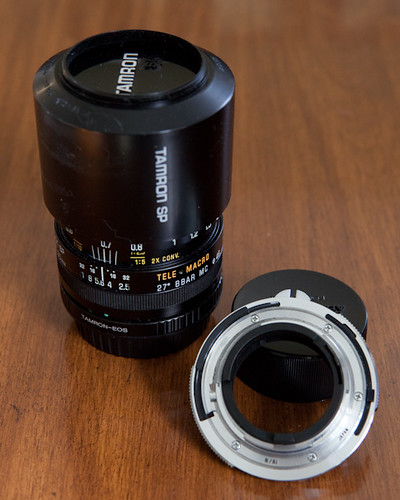
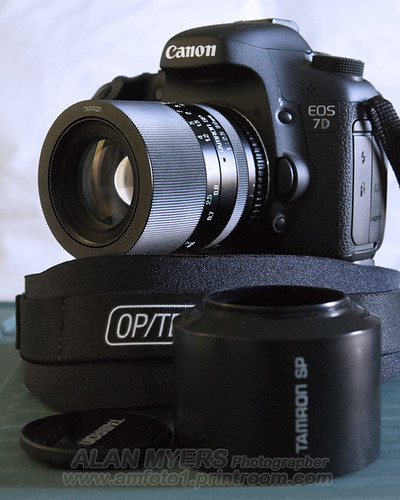
And here are several images made with that lens on the Canon camera:
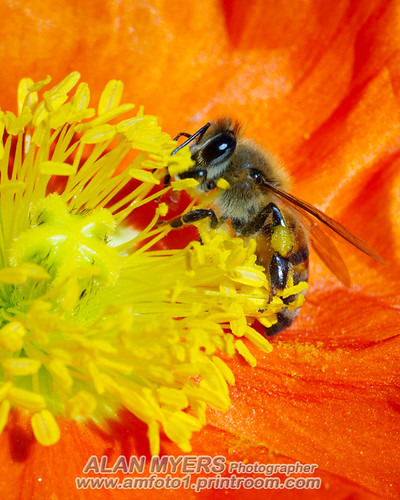
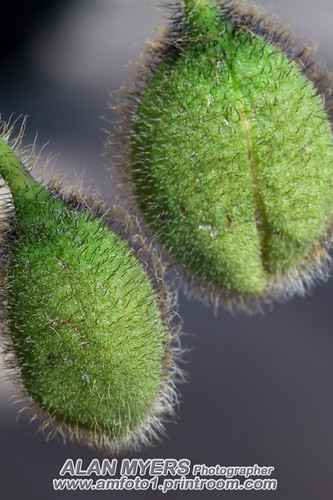
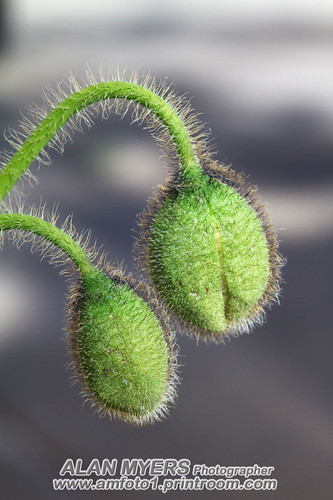
Pretty good for a $60 lens, huh? The shot of the bee on the left and the poppy buds in the center images were both done with a 20mm or 25mm extension on the lens. Natively, it's a 1:2 macro lens... able to do half life size, as is shown in the shot of the poppy buds on the right. To get the lens closer to full 1:1, as seen in the left and center images, I added the extension tube between the lens and the camera.
This is just one example of what's possible. There are A LOT of other possibilities.
But working with a vintage, manual focus/manual aperture lens like this is a bit challenging. When stopped down, your viewfinder dims down. I was using f/11 for the above images (smaller f-stops are often needed with close-ups, because depth of field gets very shallow). But the dim viewfinder makes manual focusing difficult. In some situations, Live View can be used, with Exposure Simulation enabled, to brighten up the view and help with manual focus. However, that doesn't work very well with fast moving subjects like bees! I probably took 75 shots to get 2 or 3 good ones in focus, well posed and nicely composed, of the bee in the above shot. I was lucky it was working from flower to flower and gave me lots of opportunities.
Another thing that can help (and the reason the Adaptall mount I bought cost $40 instead of $25) is a "chipped" adapter. It has an electronic chip installed on the adapter, the main purpose of which is that it allows Canon Focus Confirmation to work (camera first needs to be set to One Shot and an AF point selected, while a native EF/EF-S lens is still installed). This gives a "beep" and a visual confirmation in the viewfinder when focus is achieved. It works well with manual focus lenses, until the lens aperture is stopped down a lot. With my lens set to f/11 for the shots above, it worked... although a bit slowly... and only because the subjects were in full sun. It probably wouldn't have worked in shade.
With adapted lenses like these, the camera can still work in Av (aperture priority) auto exposure mode... Or in M (fully manual) using the built in light meter to make settings. Metering is done "through the lens", so it takes into account manually stopped down aperture settings of the lens. It might also be possible to use M with Auto ISO... I've never tried it, but that's another auto exposure mode. Exposure Compensation also can be used with Av (and maybe with M w/Auto ISO). With a vintage, manual focus, manual aperture lens like this you CANNOT use any of the Scene modes, "A+", Tv (shutter priority AE) or P (program AE) modes with a lens like this. There's no way for the camera to control the lens aperture, which is necessary for all these exposure modes.
To summarize... first I'd recommend you get macro extension tubes. I learned to use them 25 or 30 years ago and have always had some in my camera bag ever since. I've used them on lenses from 20mm to 500mm, though most often on focal lengths from around 50mm to 135mm. Macro extension tubes are affordable, easy to use and can do a good job. Get them and start experimenting with them.
Also keep your eyes open for a good deal on a vintage macro lens, if interested. You'll need to learn what's most easily adapted for use on your DSLR... and what's not. Or you may need to watch for one with interchangeable mount that you can get to fit EOS/EF. I know T-mount and Adaptall mounts are widely avail.... some of the other, less common types may be too... I don't know. There's lots of info on the Internet about vintage macro lenses, which you might research, too. Some of those lenses from the 1960s, 70s and 80s are excellent and cheap compared to modern lenses.
There are also some relatively affordable modern, auto focus, electronic aperture macro lenses. The Tokina AT-X Pro 100mm f/2.8 sells new for around $350. The Canon EF-S 60mm f/2.8 USM is a little more. There also have been and still are several modern auto focus versions of the Tamron 90mm (descendants of the lens shown above, so to speak). My most-used macro lens is the Canon 100mm f/2.8 USM (not the more expensive L/IS version).... Canon's 100mm are the ONLY macro lenses around this focal length that can optionally be fitted with a tripod mounting ring, which is a very handy feature (Canon and other brands 150mm, 180mm and 200mm have tripod rings... So does Canon's MP-E 65mm macro, but that's an ultra high magnification lens and very specialized).
Personally I use the Canon 100mm, 180mm and MP-E 65mm macro lenses, in addition to the vintage manual focus Tamron shown above. I also have a modern Tamron SP 60mm f/2 macro, which is compact and takes place of several lenses (both macro & portrait) in my bag, when I don't know if I'll need macro. I also sometimes use a Canon 45mm Tilt-Shift lens for close up work. In the past I've used the 90mm Tilt-Shift, too, but don't currently have one. For shyer subjects I sometimes do close-ups with 300mm and 100-400mm telephotos, with macro extension tubes when the approx. 1/3 life size they are capable of isn't enough magnification.
There are LOTS of ways to "do macro" and close-ups!
Hope this helps!
Feb 27, 2019 12:05:30 #
Feb 27, 2019 16:33:37 #
I have taken a lot of macro photos of my model trains over the years. The screw on +1,2,4 lens sets for <$20 on ebay work very well, a macro lens (I have a sigma 50mm macro), and Vivitar made a 2x MACRO teleconverter for Nikon, Canon, and ? another brand. It runs about $40 on ebay and is very good with your 50mm lens. It works well. Extension tubes have no depth of field and I find the other options above better. You can get a ring LIGHT for about $30 on Amazon or Ebay. It is not a flash; turn the light on and take your photo for camera metering.
Feb 27, 2019 22:58:21 #
Great info everyone, thanks to all of you for passing on your experience. Sounds like there's a "gazillion" different ways to accomplish the task, some better, some preferred. Not sure which way I'm going, though, right now I'm leaning toward a "no glass" adapter for the MD 50mm 1.7 to get started. The current adapter w/glass was purchased from Adorama for about $40.00. With which I've done a few test shots. IMHO, it compares favorably to the Canon 18-55 kit lens, as a general photography piece, benefiting, I'm sure from the lower f-stop capability, so I think for the time being I'll leave the glass in the adapter. I'm a little leary of reversing the MD lens. Not sure I like exposing the inside glass to the elements. As I get further into this, I'll try to post some images and we'll see. Hopefully others will gain from the experience as well. Thanks again for sharing your expertise.
Feb 28, 2019 00:55:02 #
The Can Man
Loc: Big Arm, Montana
Same here, I use a cheap three tube set up I bought for $12 off wish. Shipping speed was miserably slow. But that’s normal for Wish.
Feb 28, 2019 05:19:30 #
RWR
Loc: La Mesa, CA
CanonAbuser wrote:
Great info everyone, thanks to all of you for pass... (show quote)
When you reverse a 50mm lens you’ll be magnifying around 1X or so, just with the reversing ring. A short extension tube will serve as a hood for the reversed lens, and afford some protection. For some mounts there are rings available for a reversed lens - some with filter threads, diaphragm control, &c.
You’ll find about all you want to know in the links on the first page of the True Macro section. Have fun!
Mar 1, 2019 17:06:43 #
CanonAbuser wrote:
Greetings, I'm a newby to DSLR's and I'll likely t... (show quote)
You don't say what lenses you have besides the 50mm. If you have a longer telephoto, like 70-300mm, you can use that for close-up shots. Not as good as with a true macro lens, but still get great magnification and bokeh.
Mar 2, 2019 12:54:56 #
SusanFromVermont wrote:
You don't say what lenses you have besides the 50mm. If you have a longer telephoto, like 70-300mm, you can use that for close-up shots. Not as good as with a true macro lens, but still get great magnification and bokeh.
Glad you brought that up. The kit lenses are the 18 -55 is and the 75-300 zoom which I've tried. Good close ups but not really what I'd consider in the macro range.
Mar 2, 2019 15:18:35 #
CanonAbuser wrote:
Glad you brought that up. The kit lenses are the 18 -55 is and the 75-300 zoom which I've tried. Good close ups but not really what I'd consider in the macro range.
No, not true macro. But can be cropped down and retain a good amount of detail. I just mentioned it in case you had to wait before buying a good macro lens. I recommend longer focal lengths if you are doing critters that will spook if you get too close! 105mm is good, I have a 150mm macro lens because I love to do butterflies, bees, ants, etc.
Mar 2, 2019 15:33:15 #
CanonAbuser wrote:
Greetings, I'm a newby to DSLR's and I'll likely t... (show quote)
Chris, if your budget is restrained you can start with a set of tubes and your 50mm, you won't have to buy expensive tubes that control focus and aperture but I would recommend it for later, and possibly for using the two lenses that came with your camera.
If you click on the flickr link below this post you can see some of my Macro the vast majority of which was done with an old Minolta film era 28mm lens reversed on to a set of M42 tubes, the cost of that set up was about $50, however I spent a bit more on the flash solution used for that set up, an off camera flash set up thanks to Yongnuo will cost you just over $100 and then an articulating arm set up would be at least that much again.
Mar 2, 2019 17:05:07 #
SusanFromVermont wrote:
No, not true macro. But can be cropped down and retain a good amount of detail. I just mentioned it in case you had to wait before buying a good macro lens. I recommend longer focal lengths if you are doing critters that will spook if you get too close! 105mm is good, I have a 150mm macro lens because I love to do butterflies, bees, ants, etc.
Good point, I was focused (pun intended) on the hardware , yes these images should respond well to a fair amount of cropping.
Thanks for the reminder 😊.
Mar 2, 2019 17:17:04 #
Blurryeyed wrote:
Chris, if your budget is restrained you can start ... (show quote)
Good suggestion. I'd like to try a no lens version of the MD to EOS adapter as they are advertised as macro only or at least no infinity focus. I'm curious as to how close I can get to the subject with just the adapter and 50 mm lens. I realize the tubes are a closer focus.
If you want to reply, then register here. Registration is free and your account is created instantly, so you can post right away.



